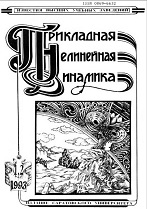|
METHODICAL PAPERS IN NONLINEAR DYNAMICS
Nonlinear perturbation theory based on the variational principle: Model examples
V. V. Uchaikina, V. A. Litvinovb
a Ulyanovsk State University
b Barnaul Law Institute of the Ministry of Internal Affairs of the Russian Federation
Abstract:
Topic and aim. It is known that the dual representation of problems (via the basic and conjugate functions in the Lagrange sense) allows us to formulate an effective version of the theory of small perturbations, but expanding its scope by including the next terms in the perturbation theory series sharply complicates the solution procedure. In this regard, a number of works have been undertaken to find alternative approaches. Among them is the method of variational interpolation (VI-method), proposed by V.V. Uchaikin, which uses not one, as it is in the perturbation theory, but several reference problems with known solutions. The purpose of the article is to demonstrate some peculiarities of the method in applications to specific model problems. Models investigated. The investigations are carried out on the examples of solving several model problems in the transport theory, in simplified formulations representing diffusion problems, neutron transport, charged particles, and waves. Results. The solution of the parabolic equation for the wave amplitude was considered in the region where the firstorder approximation of perturbation theory is inapplicable, whereas the VI-method showed results that practically coincide with the results given by the finite-difference method, although for the chosen depths the reference («unperturbed») the desired solution differs by an order of magnitude from the reference ones, and the computation didn't exceed in complexity of the first-order approximation of perturbation theory. A similar situation is observed in the case of the application of the VI-method to the problem of the passage of radiation in a non-scattering medium and in the stationary problem of diffusion in a homogeneous layer with given absorption coefficients $s$ and diffusion $l$. Discussion. The latter case is more most interesting and visible for discussion, since it leads to the error topogram on the plane $(s ; l)$. In this formulation of the problem, the desired functional is simply a function of the two material variables, but in a more general (and interesting) case it can turn out to be a functional of functions characterizing the space-time dependence of local material properties of the medium.
Keywords:
perturbation theory, adjoint function, stationary functional.
Received: 06.07.2018
Citation:
V. V. Uchaikin, V. A. Litvinov, “Nonlinear perturbation theory based on the variational principle: Model examples”, Izvestiya VUZ. Applied Nonlinear Dynamics, 26:6 (2018), 82–98
Linking options:
https://www.mathnet.ru/eng/ivp18 https://www.mathnet.ru/eng/ivp/v26/i6/p82
|

| Statistics & downloads: |
| Abstract page: | 113 | | Full-text PDF : | 56 |
|




 Contact us:
Contact us: Terms of Use
Terms of Use
 Registration to the website
Registration to the website Logotypes
Logotypes








 Citation in format
Citation in format 